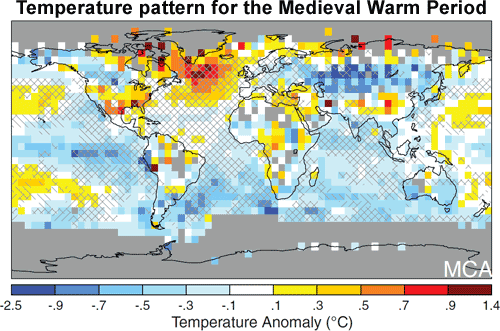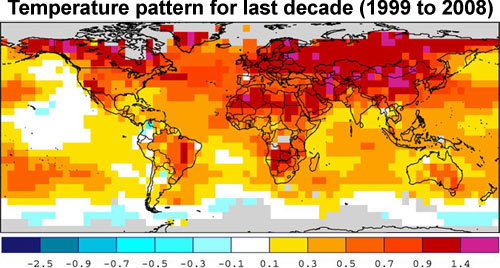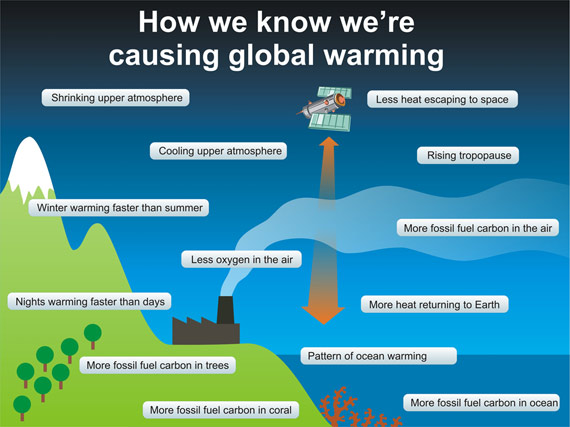No, Greenland Wasn't Green
Posted on 26 November 2013 by Anne-Marie Blackburn
This is an update to the basic rebuttal to the myth Greenland was green
Greenland is a large area situated east of Canada, between the Arctic and Atlantic oceans. About 80% of the island is covered by the Greenland ice sheet. During the 980s, Scandinavian and Icelandic exporers established two or three settlements on the south-west coast of Greenland. So what were the conditions in Greeland like 1,000 years ago? More precisely, let's explore the three following questions:
- How old is the Greenland ice sheet?
- Is there evidence of global warming at that time?
- What factors cause climate change?
The Greenland ice sheet is at least 400,000 years old
Scientists have estimated that the Greenland ice sheet is between 400,000 and 800,000 years old. This means that the island today is unlikely to have been markedly different when Europeans settled there. However, there is evidence that the settled areas were warmer than today, with large birch woodlands providing both timber and fuel. This warmth coincided with the period known as the Medieval Climatic Anomaly, also known as the Medieval Warm Period, which we will discuss below.
So how did Greenland get its name? According to the Icelandic sagas, Erik the Red named it Greenland in an attempt to lure settlers in search of land and the promise of a better life. However, the age of the ice sheet, which is more than 3 kilometres thick in places and covers 80% of Greenland, proves that the opportunities to establish communities would have been limited to rather small areas.
Warming during the Medieval Climatic Anomaly was not global
During the Medieval Climatic Anomaly, some areas, most notably in the North Atlantic and parts of Europe, were at least as warm as today, if not warmer. However, other areas were colder, and overall evidence suggests that global temperatures during this period were similar to those at the beginning or middle of the 20th century, and colder than today. This period is explored in more depth here.
So not only was Greenland already mostly covered in ice when Europeans settled there, but also the relatively warm conditions during this period were not a global phenomenon. This contrasts with what we are seeing today, where warming is truly global. Figure 1 is a map showing reconstructions of temperature anomalies during the Medieval Warm Period. Blue colours show lower temperatures and warm colours show higher temperatures when compared to the 1961-1990 reference period.

Figure 1 - Reconstructed surface temperature anomalies for the Medieval Warm Period (950-1250) compared to a 1961-1990 reference period. (Source: Mann et al., 2009)
We can compare this with a similar reconstruction looking at surface temperature anomalies for the 1999 to 2008 period. This clearly shows the global nature of recent warming.

Figure 2 - Surface temperature anomaly for period 1999 to 2008, relative to the 1961– 1990 reference period. (Source: NOAA)
Natural versus man-made climate change
Warming can be the result of a number of factors, so that the cause of past climate change is not necessarily implicated in current climate change. For instance, the Medieval Climatic Anomaly was characterised by relatively high solar activity, low volcanic activity and possible changes in ocean circulation patterns. These factors can explain both the scale and pattern of warmth at that time. However, they cannot explain recent warming. More to the point, changes in natural factors would probably have led to cooling in the past few decades. This contrasts with the multiple lines of evidence pointing to the role played by humans in recent warming, as illustrated by the the graph below.

Conclusion
Greenland is unlikely to have been radically different 1,000 years ago since the ice sheet is at least 400,000 years old. So the evidence shows that not only was Greenland not green, the warmth was mainly a regional phenomenon caused by natural factors. Compare this with the unequivocal findings of the scientific community regarding ongoing warming: climate change now is global and in all likelihood driven primarily by human activities.
The key points can be summarised as follows:
- The Greenland ice sheet already covered large sections of Greenland when Europeans established communities there 1,000 years ago
- Warming was not global during the Medieval Climatic Anomaly; average global temperatures were lower than today
- Natural factors behind regional warming in medieval Greenland are probably not responsible for today's global warming































 Arguments
Arguments






























From the 13th century Saga of Eric the Red (Eiríks saga rauða):
The history of the Greenland settlements is described in some detail in chapters 7&8, pages 211-276 of Jared Diamond's book 'Collapse - How societies choose to fail or succeed' published 2005 by Penguin.
Diamond states that:
"According to the sagas and medieval histories, around the year 980 a hot-blooded Norwegian known as Eric the Red was charged with murder and forced to leave for Iceland, where he soon killed a few more people and was chased out to another part of Iceland. Having ended up, there too, in a quarrel and killed still more people, he was this time exiled entirely from Iceland for three years ...
... Eric ... spent the next three years exploring much of the Greenland coast, and discovered good pastureland inside the deep fiords. On his return to Iceland he lost yet another fight, impelling him to lead a fleet of 25 ships to settle the newly explored land that he shrewdly named Greenland."
There is already extensive discussion of the Viking settlement of Greenland in comments here, and especially here, starting with the comments of Spoonieduck and leading on to extensive rebutals. Sufise it to say that the evidence supports the claims that:
As a minor point, the blog above appears to have already replaced the former content at the first link in my post (as is intended), but the update information has not been updated.
The vikings saw a few green coastal areas, but obviously not the interior and its vast scope. The term greenland was wishful thinking, or ignorance, or a marketing ploy to attract people.
What caused the medieval warm period of europe? Presumably it could happen again, and seems to have had a reasonably rapid onset. Imagine if this was overlaid over human induced warming. This could have unpredictable and unwanted consequences to say the least.
"men will desire much the more to go there if the land has a good name"
Yeah. Lets never forget he was a Property Developer
Glenn@5,
Doe you have a reference to that? Half joking, half seriously, I've heard all sorts of stories who he was (warrior, killer, outcast) but this one looks as your invention unless you prove otherwise...
The statement "So not only was Greenland already mostly covered in ice when Europeans settled there" is too vague. There is literature that can quantify this much better indicating the maximum retreat in the Holocene was before 4000 BP and the margin retreat was on the order of 10-15 km, which compared to the whole ice sheet width is quite small indeed.
http://www.sciencedirect.com/science/article/pii/S0031018212800101
http://www.sciencedirect.com/science/article/pii/S0277379112004209
http://www.glyfac.buffalo.edu/Faculty/briner/buf/pubs/Briner_et_al_2010.pdf
mspelto, thanks for the feedback. I think it's worth remembering that this is the basic version of the Greenland was green rebuttal, so my aim was to keep the message simple and highlight the key points only. I think it would be good to use the links you provide in the intermediate version of the rebuttal - I'll have a word with John and see if that rebuttal should be updated.
Good work. Sorry to be pedantic, but there are a couple of typos:
Scandinavian and Icelandic exporers established two or three settlements on the south-west coast of Greenland. So what were the conditions in Greeland like 1,000 years ago?
A fairly thorough evaluation of Holocene Greenland temperature history and human migration was published by PNAS in 2011:
“Abrupt Holocene climate change as an important factor for human migration in West Greenland” William J. D’Andreaa,Yongsong Huanga,Sherilyn C. Fritzb, and N. John Anderson, PNAS ∣ June 14, 2011 ∣ vol. 108 ∣ no. 24 ∣ 9765–9769.
Abstract: West Greenland has had multiple episodes of human colonization and cultural transitions over the past 4,500 y. However, the explanations for these large-scale human migrations are varied, including climatic factors, resistance to adaptation, economic marginalization, mercantile exploration, and hostile neighborhood interactions. Evaluating the potential role of climate change is complicated by the lack of quantitative paleoclimate reconstructions near settlement areas and by the relative stability of Holocene temperature derived from ice cores atop the Greenland ice sheet. Here we present high-resolution records of temperature over the past 5,600 y based on alkenone unsaturation in sediments of two lakes in West Greenland. We find that major temperature changes in the past 4,500 y occurred abruptly (within decades), and were coeval in timing with the archaeological records of settlement and abandonment of the Saqqaq, Dorset, and Norse cultures, which suggests that abrupt temperature changes profoundly impacted human civilization in the region. Temperature variations in West Greenland display an antiphased relationship to temperature changes in Ireland over centennial to millennial timescales, resembling the interannual to multidecadal temperature seesaw associated with the North Atlantic Oscillation.
Link: http://www.pnas.org/content/108/24/9765.long
It is available to the public. Figures 3 and 4 have temperature reconstructions by several methods and the text discusses the detailed relationship to emergence and decline of various cultures.